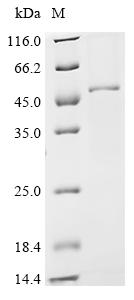Recombinant Mouse Double-stranded RNA-specific adenosine deaminase (Adar) , partial
CAT:
399-CSB-EP859990MO-01
Size:
1 mg
Price:
Ask
- Availability: 24/48H Stock Items & 2 to 6 Weeks non Stock Items.
- Dry Ice Shipment: No




Recombinant Mouse Double-stranded RNA-specific adenosine deaminase (Adar) , partial
- CAS Number: 9000-83-3
- Gene Name: Adar
- UniProt: Q99MU3
- Expression Region: 835-1170aa
- Organism: Mus musculus
- Target Sequence: SLGTGNRCVKGDSLSLKGETVNDCHAEIISRRGFIRFLYSELMKYNHHTAKNSIFELARGGEKLQIKKTVSFHLYISTAPCGDGALFDKSCSDRAVESTESRHYPVFENPKQGKLRTKVENGEGTIPVESSDIVPTWDGIRLGERLRTMSCSDKILRWNVLGLQGALLTHFLQPVYLKSVTLGYLFSQGHLTRAICCRVTRDGKAFEDGLRYPFIVNHPKVGRVSVYDSKRQSGKTKETSVNWCMADGYDLEILDGTRGTVDGPGKELSRVSKKNIFLQFKKLCSFRARRDLLQLSYGEAKKAARDYDLAKNYFKKSLRDMGYGNWISKPQEEKNF
- Tag: C-terminal 6xHis-tagged
- Source: E.coli
- Field of Research: Epigenetics and Nuclear Signaling
- Assay Type: Developed Protein
- Relevance: Catalyzes the hydrolytic deamination of adenosine to inosine in double-stranded RNA (dsRNA) referred to as A-to-I RNA editing. This may affect gene expression and function in a number of ways that include mRNA translation by changing codons and hence the amino acid sequence of proteins since the translational machinery read the inosine as a guanosine; pre-mRNA splicing by altering splice site recognition sequences; RNA stability by changing sequences involved in nuclease recognition; genetic stability in the case of RNA virus genomes by changing sequences during viral RNA replication; and RNA structure-dependent activities such as microRNA production or targeting or protein-RNA interactions. Can edit both viral and cellular RNAs and can edit RNAs at multiple sites (hyper-editing) or at specific sites (site-specific editing). Its cellular RNA substrates include: bladder cancer-associated protein (BLCAP), neurotransmitter receptors for glutamate (GRIA2) and serotonin (HTR2C) and GABA receptor (GABRA3). Site-specific RNA editing of transcripts encoding these proteins results in amino acid substitutions which consequently alters their functional activities. Exhibits low-level editing at the GRIA2 Q/R site, but edits efficiently at the R/G site and HOTSPOT1. Does not affect polyomavirus replication but provides protection against virus-induced cytopathic effects. Essential for embryonic development and cell survival and plays a critical role in the maintenance of hematopoietic stem cells.
- Purity: Greater than 95% as determined by SDS-PAGE.
- Activity: Not Test
- Length: Partial
- Form: Liquid or Lyophilized powder
- Buffer: If the delivery form is liquid, the default storage buffer is Tris/PBS-based buffer, 5%-50% glycerol. If the delivery form is lyophilized powder, the buffer before lyophilization is Tris/PBS-based buffer, 6% Trehalose, pH 8.0.
- Reconstitution: We recommend that this vial be briefly centrifuged prior to opening to bring the contents to the bottom. Please reconstitute protein in deionized sterile water to a concentration of 0.1-1.0 mg/mL.We recommend to add 5-50% of glycerol (final concentration) and aliquot for long-term storage at -20℃/-80℃. Our default final concentration of glycerol is 50%. Customers could use it as reference.
- Molecular Weight: 44.9 kDa
- Storage Conditions: The shelf life is related to many factors, storage state, buffer ingredients, storage temperature and the stability of the protein itself. Generally, the shelf life of liquid form is 6 months at -20℃/-80℃. The shelf life of lyophilized form is 12 months at -20℃/-80℃.
